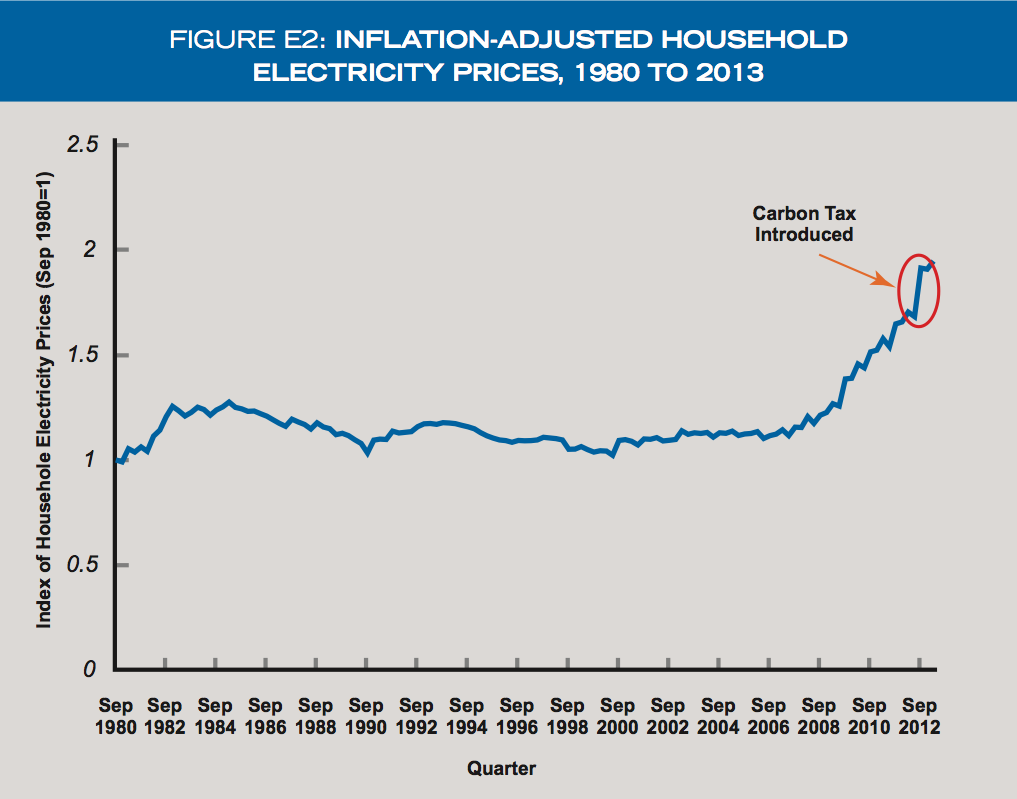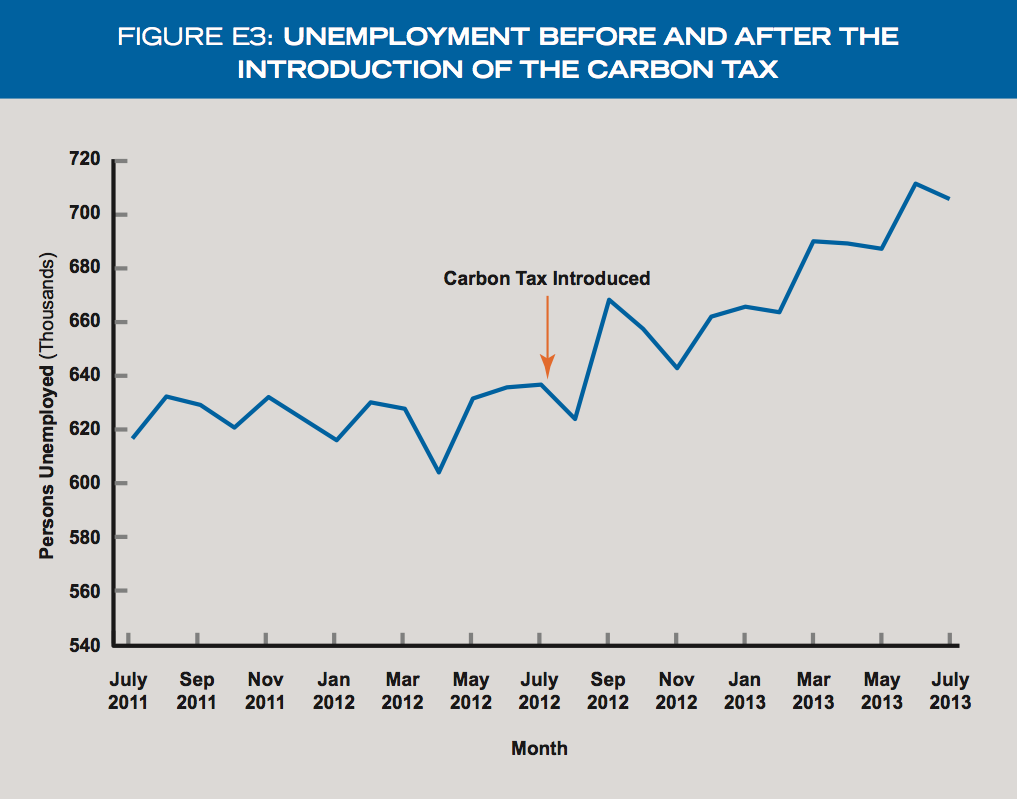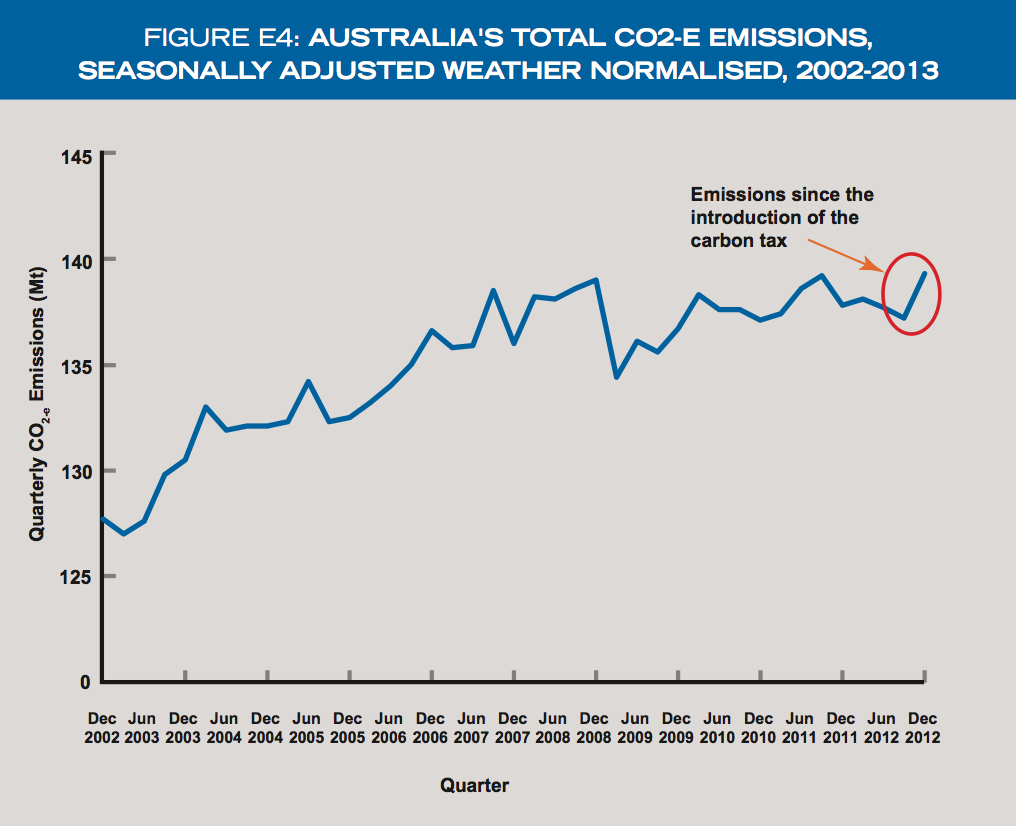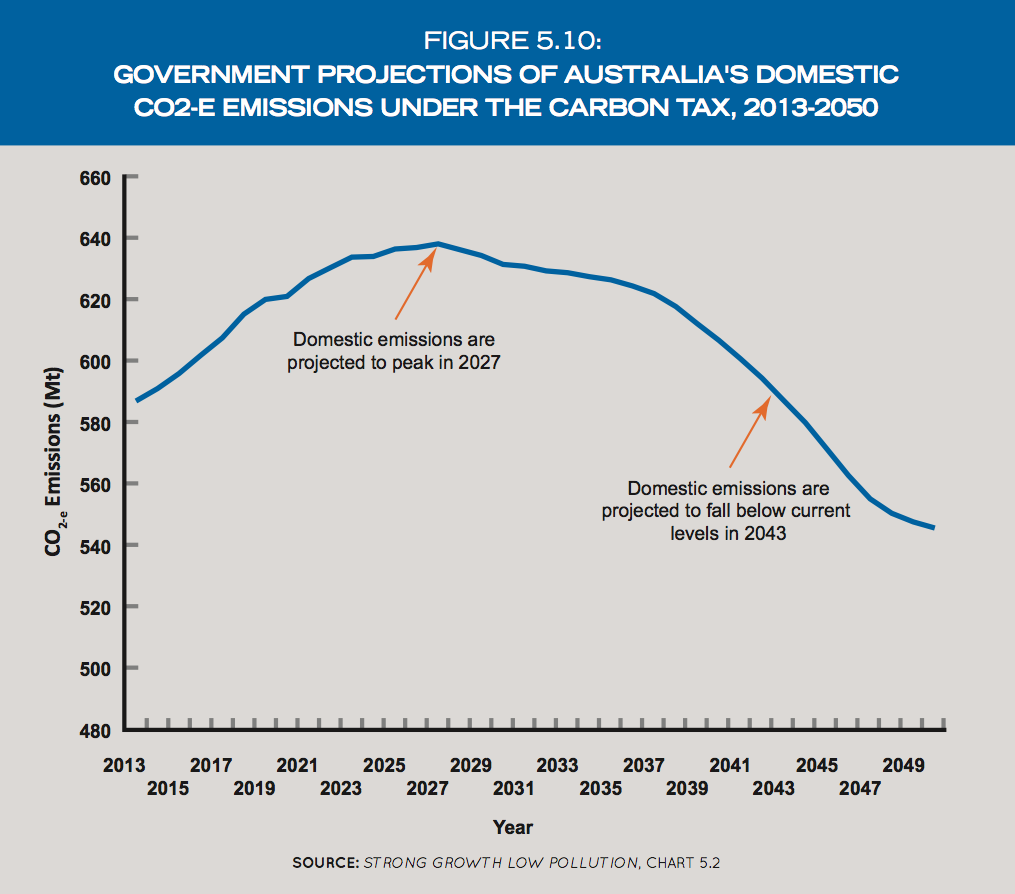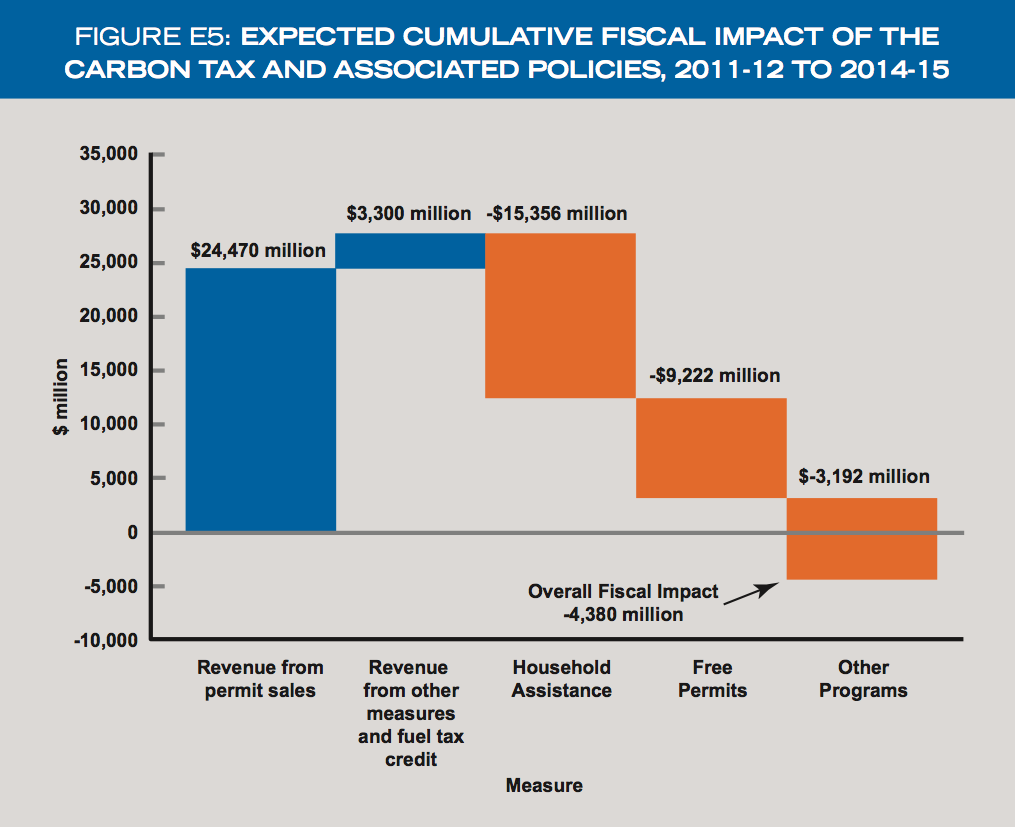In Australia’s upcoming September 7 elections, a key issue will be the carbon tax, which the government enacted on July 1, 2012, at $23 (Australian dollars) per ton of CO2 equivalent, and raised to $24.15/ton on July 1, 2013. Dr. Alex Robson, an economics professor from Griffith University in Brisbane, Australia, has written a new study documenting lessons for U.S. and other policymakers. In this post I’ll summarize some of Dr. Robson’s key findings. The real-world results in Australia throw cold water on the claims made by proponents of a U.S. carbon tax, particularly the people saying it is a “conservative” and “pro-growth” policy. Every single claim they make in their case for a U.S. carbon tax had the opposite effect in Australia.
Australia: Spike in Electricity Prices and Rising Unemployment
In the year after Australia’s carbon tax was introduced, household electricity prices rose 15%, including the biggest quarterly increase on record. Currently 19% of the typical household’s electricity bill is due to Australia’s carbon tax and other “green” programs such as a renewable energy mandate. The following chart from Robson’s study illustrates:
The job market had previously been stable, but after Australia’s carbon tax the number of unemployed began rising rapidly. Robson’s chart shows the gory details:
In addition to the total number of unemployed, there are numerous examples of specific businesses laying off workers and/or shutting down because of the carbon tax. Here is just one example from the study:
11 March 2013: CSR announced a restructure of its glass manufacturing business, Viridian, with the loss of 150 jobs overall at two sites – Ingleburn and Wetherill Park. Rob Sindel, the Managing Director, confirmed that the carbon tax had added around $500,000 to the annual costs at its Ingleburn facility. [Robson, page 39]
Immediate Spike in Emissions
So if Australia’s carbon tax thus far has led to a large spike in electricity prices, and rising unemployment, what about the environmental benefits? Did it lead to a slowdown in emission growth?
Ironically, no. Look at what happened to total emissions since introduction of the tax:
And even according to the government’s own projections, the carbon tax (which is scheduled to morph into a cap-and-trade scheme in 2015) will still allow for total Australian emissions to rise through the year 2027, and they will not fall below current levels until the year 2043:
Why such a low “bang for the buck”? Robson explains that by its design, Australia’s carbon scheme allows for significant emissions reductions to be achieved in foreign jurisdictions. In other words, Australian businesses can pay for foreign “abatement” and continue domestic emissions. This should make even die-hard environmentalists wary, as it becomes clear that in practice, governments are using their anti-carbon mindset merely as a way to enact new measures with hard-to-monitor loopholes that don’t really achieve environmental goals.
The Australian Experience Obliterates the “Conservative” Case for a Carbon Tax
Robson’s new study also explodes the fantasies put forth by a small but vocal group in the U.S. who claim that a carbon tax is a “pro-growth” policy. In future posts I’ll elaborate on these points, but to provide a quick summary:
- Australia’s carbon tax led to income tax hikes. The key claim for the “conservative” case for a U.S. carbon tax is that the new revenue would allow for “pro-growth” cuts in other taxes. But in Australia, the carbon tax was accompanied by so many give-aways (to mitigate the impact on various groups with political pull) that the Australian government actually raised effective marginal income tax rates on 2.2 million taxpayers, compared to income tax reductions for only 560,000 taxpayers, meaning more Australians saw their marginal income tax rates go up, rather than down, by a margin of almost 4-to-1.
- Australia’s carbon tax ushered in more inefficient energy regulations, not fewer. The Australian carbon tax was not accompanied by any reform of their inefficient wind and solar subsidies, or Renewable Energy Target (RET) mandates. In fact, Australia’s carbon tax was instituted along with a “Clean Energy Finance Corporation,” showing that it led to more command-and-control regulations, and more entry points for the politically-connected.
- Australia’s carbon tax has led to more policy uncertainty. Another key claim is that a U.S. carbon tax will establish a predictable “price” for carbon that firms can incorporate into their long-term investment plans. Yet in Australia, the carbon tax has been a comedy of errors. Originally the government promised during the 2010 campaign that it would not implement a carbon tax in the next 3-year cycle. That quickly went out the window, with the new carbon tax introduced in July 2012, with a planned transition to a cap and trade scheme in 2015, which at that time would be subject to floor and ceiling prices on the emission permits. However, in the very next month after introducing the carbon tax, the government announced that there would no longer be a floor price. Recently the government has proposed to move earlier towards a cap and trade scheme, with the new transition taking place on July 2014. Depending on the result of the forthcoming September 7 Australian election, the tax may either remain in place and transition to cap and trade in 2015, or it may move to a cap and trade scheme in 2014, or it may be abolished. The “policy certainty” of a carbon tax is yet another bogus promise.
- The carbon tax made Australia’s budget deficit worse. Another key claim is that a carbon tax will help reduce the U.S. federal budget deficit. Yet in Australia, because of the changes in income taxes and new spending programs designed to offset the impacts of the tax, for the first three years they are projecting a net loss to the Treasury of $4.4 billion. Here’s the chart from Robson’s study:
Conclusion
Dr. Alex Robson is a serious academic who has published peer-reviewed technical papers on the interaction of public finance with environmental policy. His new study documents Australia’s first-hand experience with a carbon tax. The result has been sharply rising electricity prices and unemployment, with no demonstrated benefit in emission reductions.
Moreover, the promises of those calling for a “pro-growth” U.S. carbon tax have been have been proven to be utterly false in Australia: Its carbon tax came with income tax increases and fewer jobs as well as more command-and-control energy regulations. The debate over a carbon tax is now not just one of theoretical speculation; proponents need to explain why the U.S. outcome would be different from what actually happened in Australia.


